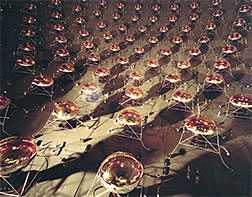- Number 402 |
- December 2, 2013
Rare neutrino scattering events shine light on the nature of matter

A close-up of the light sensors inside the
MiniBooNE neutrino detector.
Credit: Fermilab
Neutrinos are a great tool to learn more about the subatomic structure of matter and the nature of our universe. Results from the MiniBooNE experiment at DOE’s Fermi National Accelerator Laboratory now help scientists better understand the nuclear structure of protons and neutrons, explore the nature of neutrino oscillations and search for dark matter.
Neutrinos interact with other building blocks of matter only via the weak force, mediated by two types of particles: the charged W boson and the electrically neutral Z boson. Each type of boson weighs almost 100 times more than a proton, and the origin of their masses is closely connected to the existence of the famous Higgs boson.
Using a neutrino beam generated by Fermilab’s particle accelerator complex, the MiniBooNE scientists have made the world’s best measurement of the difficult-to-detect process in which a neutrino interacts via a Z boson with a proton or neutron inside an atomic nucleus.
The MiniBooNE collaboration has observed a world record of more than 150,000 of these rare Z boson scattering events. The only previous measurement with reasonable statistics of this interaction was made by Brookhaven Lab 's E734 experiment in 1987, which recorded a few thousand scattering events.
[Kurt Riesselmann, 630.840.3351,
media@fnal.gov]
